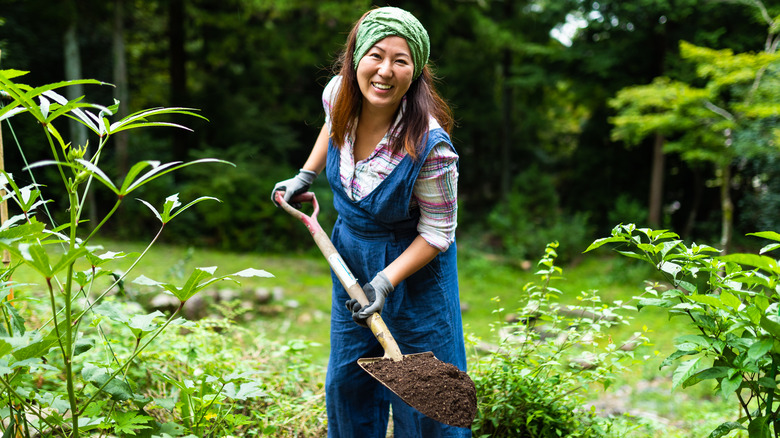The Easiest Way To Start Composting Without A Bin
Composting feels a little like magic: you take waste and transform it into a garden-boosting soil additive. If you have space in your yard, you can start composting — there's actually no need for a compost bin. This method is called trench composting: you'll simply dig a trench and bury scraps in it anywhere you want a soil boost. The microbes will work their magic underground, and before you know it, those scraps have been transformed into better soil. As a bonus, the trench method "hides" the composting process with its unappealing look and smell.
You'll want a trench that's about a foot deep and a foot wide, ensuring you can fill it with scraps (leaving a few inches for dirt on top, of course). While this shouldn't go directly under plants, it should go next to the plants that need a boost. Add scraps, cover the trench with dirt, and you're good to go. Just keep in mind that frozen ground in the winter will slow down the composting process. Otherwise, you can expect those scraps to become healthy soil in a matter of months.
Different methods for trench composting
The basic method can work wonders. However, you may want to try different styles of trench composting, depending on your garden and goals. One idea is to rotate trench locations. Once you've done one trench, put the next one in a different plant-adjacent area and rotate the location each growing season or every few months. This way, you'll gradually enrich all the soil in your growing areas. Alternatively, try rotating between three items: compost trenches, planting areas, and paths for walking.
You can also try composting in simple rows. Create rows of plants with space in between, then add a compost trench between each row. You can even combine this method with the rotational method, rotating which row is composted and which row is planted.
Unlike a standard compost bin, you won't need to turn, water, aerate, or otherwise maintain your trench compost. However, you'll still want to do a little work to keep things organized, especially if you're rotating locations. Create a chart or take notes to keep track of which areas you're trench composting in and when you start each one. That way, you can avoid digging up a trench until the composting process is done.
Tips for getting great results
It's important to know what's compostable and what isn't. What you put in the trench will help determine the results you get. You can use all kinds of fruit, vegetable, nut, and seed scraps, as well as eggshells and even coffee grounds and tea bags. However, avoid walnut scraps, which contain toxins that can harm plants. You'll also want to keep anything salty or oily out of the garden. If you're not sure what you can compost, the Environmental Protection Agency has a handy, detailed guide.
For faster results, break things apart into smaller pieces before adding them to your trench. This will speed up decomposition, improving your soil faster. Also, if you have dogs (or nosy wildlife), you may not want to try trench composting after all. If a compost trench gets dug up, it can become a messy problem.
Lastly, you'll want to create an effective method for gathering and transporting scraps. You can keep a tightly sealed compost bin in your kitchen. Try putting it in the freezer until it fills up so it won't smell or attract insects before it's ready for the trench. Whether you have a vegetable garden or ornamental flowers, this is a great way to reuse household waste with minimal effort.


